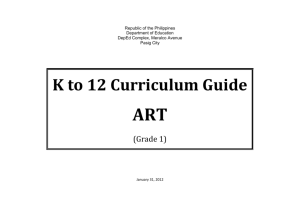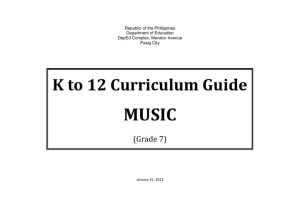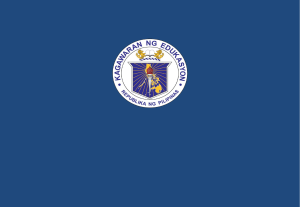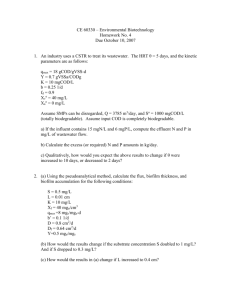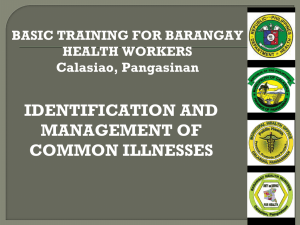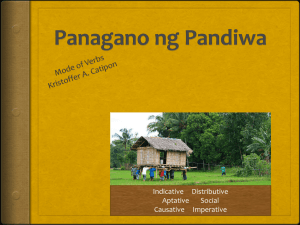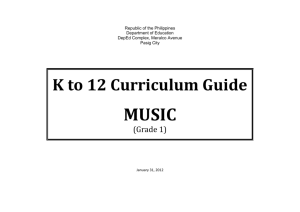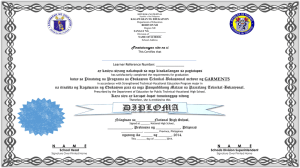art - grade 7 - DepEd Naga City
advertisement
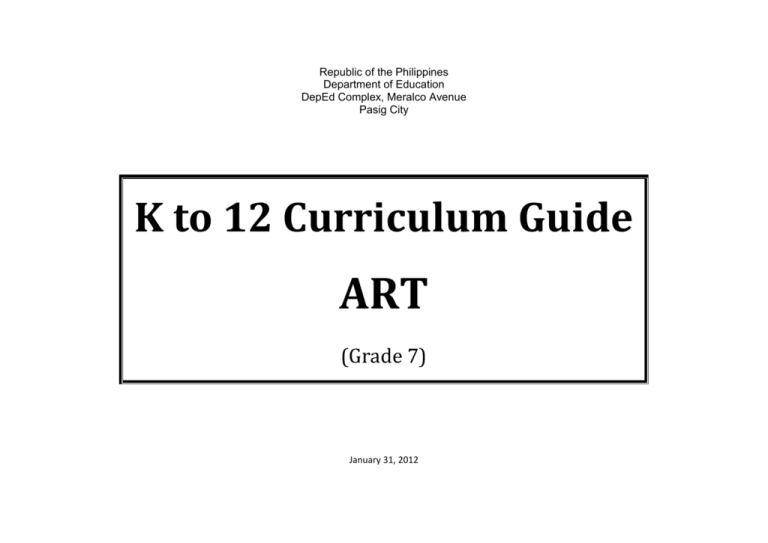
Republic of the Philippines Department of Education DepEd Complex, Meralco Avenue Pasig City K to 12 Curriculum Guide ART (Grade 7) January 31, 2012 K TO 12 MUSIC AND ART CONCEPTUAL FRAMEWORK The Music and Art curricula focus on the learner as the recipient of the knowledge, skills, and values necessary for artistic expression and cultural literacy. The design of the curricula is student-centered, based on spiral progression, and grounded in performance-based learning. Thus, the learner is empowered, through active involvement and participation, to effectively correlate music and art to the development of his/her own cultural identity and expand his/her vision of the world. As Music and Art are performance-based disciplines, effective learning occurs through active experience, participation, and performance, creative expression, aesthetic valuation, critical response, and interpretation. The skills that are developed include reading/analyzing, listening/observing, performing (singing, using musical instruments, movement, acting, and playing), responding, composing, and creating. (See Figure 1 and Figure 2). The philosophical foundations upon which standards and competencies are based include: A Process of Education by Jerome Bruner, PerformanceBased Learning by Cleve Miller, Aesthetic Education by Bennett Reimer, Multiple Intelligences by Howard Gardner, A Structure for Music Education by Ronald Thomas, Gongs and Bamboo by Jose Maceda, Compendium on the Humanities: Musical Arts produced by the National Research Council oft the Philippines, Cultural Dictionary for Filipinos by Thelma Kintanar and Associates, Creative and Mental Growth by Viktor Lowenfeld and W. Lambert Brittain, Discipline-Based Art Education by Elliot Eisner, Encyclopedia of Philippine Arts and Tuklas Sining, both produced by the Cultural Center of the Philippines. K to 12 – Curriculum Guide - version as January 31, 2012 2 K TO 12 MUSIC AND ART PHILOSOPHY AND RATIONALE FOR MUSIC EDUCATION Music is both an aural and a temporal art. All its elements, when interwoven in the highest artistic order, are likened into a ―tapestry moving in time.‖ The global weavings of this ―tapestry‖ in historical and cultural contexts are diverse—having spurred a continued metamorphosis to include a full range of purposes, functions, and identities, from the utilitarian to aesthetic. However, the basic nature of music does not change. In his book A Structure for Music Education, Ronald Thomas articulates that the nature of music is expressive, ongoing, and creative. Through a language and medium of its own, music conveys ideas and feelings in a way that addresses the human spirit, and has great value in its communicative process. Music, being responsive in interpreting contemporary times, is a continuing art. Aaron Copland describes this characteristic as a ―continuous state of becoming.‖ Like the other arts, music is a creative avenue for man’s individual quest for self- expression and fulfillment. On these basic characteristics are founded the rationale of music study. A keen sensitivity to environmental and musical sounds needs to be developed. The student must learn to ―hear,‖ ―speak,‖ and ―think‖ in the medium of music. Simultaneously, growth and development in the skills that enable the application of the learner’s knowledge should be encouraged, through active involvement in the various musical processes. Drawing from the development of music pedagogy through the years, the K-10 Music Curriculum embodies the best practices advocated by the SPIRAL, MULTI-CULTURAL, and INTEGRATIVE approaches in music education, as well as current philosophical thought about contemporary general education. We envision that Music in the K-10 Program will effectively nurture and refine the learner’s artistic expression and cultural literacy, and celebrate his/her national heritage, while it instills, within every individual Filipino learner, pride in his/her own cultural identity. K to 12 – Curriculum Guide - version as January 31, 2012 3 K TO 12 MUSIC AND ART PHILOSOPHY AND RATIONALE FOR ART EDUCATION Art has been present since the beginning of civilization since it is an integral means for man to live and communicate. It has been used to enhance man’s life and surroundings, to express thoughts, dreams, and spiritual beliefs, and to share his personal and his community’s aspirations, celebrations, and events. Art records, reflects, and rearranges man’s life and existence. Men have created objects and jewelry, woven clothing, carved furniture for their homes, utensils for eating, weapons for hunting, and icons for worshiping, by using materials from their surroundings. In our present times with the aid of technology, men have created films, animation, designs for homes and cities, and objects for various activities: communication, entertainment, agriculture, medicine and business. Art is a visualization of a people’s history and uniqueness, a reflection of their creativity and accomplishments, and a visible expression of their distinct way of thinking, communicating, reasoning, and worshipping. It is expressed in a unique symbol system that is visual, tactile, and spatial. Howard Gardner, an educator, psychologist, and researcher defines the ability of creating, seeing and understanding the arts as “SPATIAL INTELLIGENCE and INTRAPERSONAL INTELLIGENCE.” He recognizes that the Arts develop a distinct way of seeing, thinking, investigating, communicating, and creating in a person that develops creativity and innovation. The study of Art is often neglected or marginalized in the schools. Substantial research has validated the finding of Gardner that learning to use different intelligences or modes will increase the student’s ability to develop life skills, apply creative solutions in problem solving, and facilitate his collaboration with others to find new solutions. Schools therefore, need to develop the multiple intelligences of a student through the arts. The K-12 Art and Music Curriculum seeks to address the needs of our students for the 21st Century. The 21st Century is a highly visual world, with a proliferation of images seen not only in static media like magazines, books, paintings and posters. Now images are kinetic and accessible in various media: on television, outdoor advertisements, movies, cell phones, and various technologies: ipads, ipods, DVD players, personal computers, tablets, etc. Images, sounds, texts, films and videos, pictures, artworks, designs, events, produced by artists around the world, are now available at all times and are interactive involving the viewer to create, react, comment, share, and utilize these visuals through the Internet. Teaching Art to students is one way to develop his spatial and kinesthetic intelligence, so he can process and interpret the barrage of images and sounds in a critical and intelligent manner. The framework of the K-12 Art curriculum guides educators, and provides our Filipino students with art experiences that include recognizing, creating, appreciating, and critiquing their own artistic works and the works of others. From Kindergarten, art instruction begins with creative exploration of art materials, concepts and processes found in the Philippines and other countries. It continues to develop the student’s imagination and individual expression, and inquiry into the aesthetic qualities of his work, the work of others, artists of the past and present, from the Philippines and from other parts of the world. It culminates in seeing the connection of art to other areas of study and exposure to various art-related activities and careers. K to 12 – Curriculum Guide - version as January 31, 2012 4 K TO 12 MUSIC AND ART Figure 1. The Curriculum Framework of Music and Art Education K to 12 – Curriculum Guide - version as January 31, 2012 5 K TO 12 MUSIC AND ART Figure 2. Content of Music and Art per Grade Level K to 12 – Curriculum Guide - version as January 31, 2012 6 K TO 12 MUSIC AND ART Table 1. Basic Reference for Music and Art Music Elements Arts Elements and Principles Music Processes Art Processes Rhythm Color Listening Seeing/Observing Melody Line Reading Reading Form Shape/Form Imitating (re-creating) Imitating (re-creating) Timbre Value Responding Responding Dynamics Texture Creating Creating Tempo Rhythm Performing (including Movement) Performing (including Movement) Texture Balance Evaluating Evaluating Analyzing critically Analyzing critically Applying (transference) Applying (transference) Harmony * *No formal instruction in harmony from K to 3 Emphasis Proportion Harmony K to 12 – Curriculum Guide - version as January 31, 2012 7 K TO 12 MUSIC AND ART LEARNING AREA STANDARD: The learner demonstrates an understanding of basic concepts and processes in music and art through appreciation, analysis and performance for his/her self-development, celebration of his/her Filipino cultural identity and diversity, and expansion of his/her world vision. KEY STAGE STANDARDS: K–3 4–6 7 – 10 The learner demonstrates understanding of The learner demonstrates understanding of The learner demonstrates understanding of fundamental processes through basic elements and concepts through salient features of music and art of the performing, creating, and responding, performing, creating, and responding, aimed Philippines and the world, through aimed towards the development of towards the development of appreciation of appreciation, analysis, and performance, for appreciation of music and art, and music and art, and acquisition of basic self-development, the celebration of Filipino acquisition of basic knowledge and skills. knowledge and skills. cultural identity and diversity, and the expansion of one’s world vision. GRADE LEVEL STANDARDS: Grade Level Grade Level Standards Grade 7 The learner demonstrates basic understanding of the fundamental processes in music and art through performing, creating, listening and observing, and responding towards appreciation of the cultural richness of the different provinces in the Philippines K to 12 – Curriculum Guide - version as January 31, 2012 8 K TO 12 MUSIC AND ART ART - GRADE 7 Content Content Standards Performance Standards Learning Competencies Grade 7 - FIRST QUARTER The learner: Process: DRAWING & PAINTING Drawing and painting of the folk art motifs, designs found in artifacts of the cultural groups in Luzon, Visayas, Mindanao Elements: LINES organic, curvilinear geometric, linear COLORS nature-based hues; dyes primary colors secondary, tertiary colors appreciates the distinctive designs, color schemes, figures and objects coming from the cultural communities found in the three island groups. Luzon: weaving – Abra, kalinga, Vakul, pahiyas, higantes, barong Visayas – hablon, piyaya, Mindanao- kulintang, malong, torogan sees the strong influence of the Spanish (400 yrs) and Americans (50 yrs) colonizers on Phil. culture and lifeways (houses, churches, celebrations, education, food, daily utensils, clothing, accessories (paintings of churches and plazas; pictures of cottages at John Hay and Teachers Camp; Vigan, Taal, Batangas, Iloilo, Bacolod-these places still have well-preserved homes inspired by Spanish K to 12 – Curriculum Guide - version as January 31, 2012 The learner: creates a AV presentation with a group that compares the distinct artistic designs of artifacts coming from the different cultural communities from the three island groups of the Philippines and explains what inspired or influenced the design. Writes a comparative visual report on the influences of the Spanish and the Americans in the architecture of the Philippines, particularly in the churches and the houses around the plaza, and the distinct features found in it. The learner: joins a group to do a research on the culture of some indigenous communities coming from one island and creates an audio-visual presentation (drawings, paintings) for the class. joins a group to write a report on how the Spaniards and the Americans influenced the culture of the Filipinos, publishes the report with illustrations in a class publication. recreates a typical Phil. plaza by drawing/painting during the Spanish times and make a mural of this. 9 K TO 12 MUSIC AND ART Principles: architecture) REPETITION and RHYTHM of colors, shapes and lines. Grade 7 - SECOND QUARTER The learner: The learner: The learner: Process: PRINTMAKING and NEW MEDIA realizes that still pictures, film and moving images have a visual language and artistic elements different from still drawings and paintings Is able to make a short storyboard of the series of shots he is going to film and the kind of shots he will take, to be able to tell his story. understands that a story can be told through a short film with emphasis on images, color and music or sound, with dialogue not a necessary component. (Cinemalaya films; award winning TV ads; other awarded indie films by Ditsi Casimiro, etc) can analyze short films, video productions and movies and appreciates the development of the narrative through different shots employed, the use of visual clues and the use of color, music. narrates a short story, an event, a celebration, a tragedy, using a camera, cellphone or videocam to record it and present the event. has to make quick decisions about the angle of the shots, the kind of shots (close-up, long-shot, topshot,etc) and the composition of the shots while he is in the process of recording. shares the series of events he recorded to tell his story and presents it and allows his classmates to critique his pictures or film. still pictures - camera films videoclip videocam cellphones screen printing of design Elements: SHAPES, COLORS Film is a series of scenes in action; color sets mood can take pictures or record an event using a cellphone and other recording devices, and these can be shared with K to 12 – Curriculum Guide - version as January 31, 2012 can select well-composed photos and analyze its composition to show balance, emphasis and proportion of shapes and lines. 10 K TO 12 MUSIC AND ART others immediately. Principles: CONTRAST is created when opposites are combined: quiet colors and loud colors; slow action and frantic movement. knows that an original design can be replicated many times through the use of a duplicating machine. (Team Manila designs of Phil. icons, maps, places for shirts, bags,hats,; Is able to make a short storyboard of the series of shots he is going to take and kind of shots, to be able to tell his story. can analyze short films, video productions and movies and appreciate the development of the narrative through different shots, use of visual clues and use of color, music. Also Island Souvenirs design for different provinces) Grade 7 - THIRD QUARTER The learner: The learner: The learner: Process: SCULPTURE and 3D ASSEMBLAGE knows that modern sculptors and craftsmen use any material in their environment to create a 3D work. sees that among indigenous groups, it is common to create musical instruments, pots and fishing and hunting weapons, weave cloths, construct houses, according to their own distinct. designs using local materials. Mt. Province –bamboo based exhibits in his assemblage that the material is not important, but the creativity and imagination of the artist in creating an artistic assemblage reports that in indigenous communities, constructing., carving, weaving and creating what they need is part of their lifestyle and makes them selfsufficient. Creation of: installation of nature objects of Jun Yee assemblage of metal parts to create a music instrument Lirio Metal scraps sculpture of Ral Arogante Sack cloth, seeds, shells, K to 12 – Curriculum Guide - version as January 31, 2012 gathers material from his surrounding that is considered trash, and with a group, recycles this material to be part of an assemblage (plastic bottles, caps; tetra packs, straws, tin foil wrappers, etc..) which will be a creative sculpture. collects pictures of, or actual 3D artifacts from different parts of the country and research on its source, 11 K TO 12 MUSIC AND ART buttons Wall hanging by Ching Abad Sculpture- bicycle parts Picasso music instruments metal gongs, Woven baskets for food, rice. Visayas – guitars, T’boli,molded bells, jewelry, figurines.Tie-dye abaca tapestry.Maranaos-molded metal jars, gongs, weapons. Putting up a Mini Museum material, source of design, use, and put up a minimuseum , where each artifact is displayed and labeled properly for students to appreciate. looks at his own assemblage and those of others and he can judge which work is most creative and at the same time artistic. Elements: TEXTURE of found and natural objects SHAPE organic and natural shapes observes local craftsmen as they carve or create local crafts and note their mastery of the design and material, which was passed on from generation to generation. Principles: CONTRAST EMPHASIS Grade – 7 FOURTH QUARTER The learner: Identifies the unique festivals, dramas, celebrated all over the country throughout the K to 12 – Curriculum Guide - version as January 31, 2012 The learner: creates his/her own festival attire with accessories based on authentic pictures of the The learner: designs with a group the visual components of a school drama or participates in a 12 K TO 12 MUSIC AND ART Process: VISUAL ARTS IN DRAMA & FESTIVALS Baguio – Panagbenga year, and state the reason for its celebration Lucban- Pahiyas Bacolod- Maskara Aklan – Ati-atihan Davao –Kaamulan Holy Week- Moriones, SantaCruzan Pasyon Zarzuela –Bulacan & Luzon provinces Moro-moro – different provinces knows that the Filipino people love a festival, religious ritual or drama where they are required to wear special attires and costumes that show creativity and artistry since this is part of a street or public performance. where there is music and dancing. appreciates the uniqueness of festivals like the ―Pahiyas” which the townsfolk prepare for, weeks in advance by creating the colorful leaf-like kiping which hangs as décor for their homes. festivals and joins the drama group or festival community to celebrate the event. appreciates the innate artistry of the townspeople who join yearly in the festivities enthusiastically create an entirely new costume, accessories and décor every year; create a photo-essay about an outstanding local actor in a festival or drama defines what makes each of the Philippine festivals unique by a visual presentation and report. of selected festivals representing Luzon, Visayas and Mindanao. town fiesta to create: the costumes or attire, mask, headdresses, and accessories and décor and venue and stage design reports on the history of the festival and its evolution and describes how the townspeople participate and contribute to its festivity and gaiety. analyzes the uniqueness of the group that was given recognition for its performance to explain what component contributed to their being selected; Elements: COLOR TEXTURE costumes, masks, accesories, decor for venue and stage Principles: CONTRAST RHYTHM K to 12 – Curriculum Guide - version as January 31, 2012 13 K TO 12 MUSIC AND ART K to 12 – Curriculum Guide - version as January 31, 2012 14 K TO 12 MUSIC AND ART GLOSSARY OF TERMS A Abaka - isang uri ng saging na katutubo sa Pilipinas na ginagawang matibay na lubid at sako Abstract – likhang sining na hindi tulad ng tunay na bagay Analogo – kumbinasyon ng mga kulay na magkakalapit s ―color wheel Antigo – mga bagay na may Anyo – hugis o porma Arkitekto –ang gumagawà ng anyo o plano ng bahay o anumang gusalì Artipisyal na tekstura- tekstura ng artipisyal na bagay tulad ng prutas na plastic Asimetrikal-impormal na balance Ati-atihan – kasayahan para kay Sto. Nino na ginaganap sa ikatlong linggo ng Enero B Balangkas- guhit na nagpapakita ng hugis ng isang bagay Balanse –magkatulad na timbang Bantog – kilalang kilala Batik – paglalagay ng disenyo sa tela o damit sa pamamagitan ng pagtatakip sa ibang bahagi na di dapat lagyan ng kulay Biswal – nakikita Biswal na Pagdama – pag- unawa sa mga bagay na namamasid o nakikita Biswal na Tekstura – teksturang nakikilala sa pamamagitan ng pagtingin o pagmamasid Bornay – tapayan na may ibat ibang hugis at disenyo na yari sa luwad o putik K to 12 – Curriculum Guide - version as January 31, 2012 15 K TO 12 MUSIC AND ART Brotsa –gamit sa pagpipinta na yari sa ibat’ ibang hibla Bulol – imahen na inulit sa kahoy C Canao – isang socioreligious seremonya ng Igorots na ginaganap bilang pagpapasalamat para sa isang mapagbigay na ani D Dalawang Dimensyon – kaanyuan ng nakaalsang bagay Dalubhasa – may kasanayan sa paggawa; bihasa o eksperto sa isang gawain Dibuho – disenyo o pagkakaayos ng mga bagay Dinagyang – pagdiriwang na ginaganap tuwing ikaapat na Linggo ng Enero sa Iloilo upang alalahanin ang pagiging kristiyano ng mga katutubo at pagpaparangal kay Sto. Nino. Disenyong Etniko – uri ng dibuho na katutubo sa isang grupo ng tao Disenyong Manobo –kilala sa kanilang tato na gumagamit ng karayom, bamboo at iba pang gamit at pinapahiran ng ―kulipapa wood charcoal‖ at ang disenyong sarimanok. E Elemento ng Sining – katangiang matatagpuan sa isang gawaing pansinining tulad ng linya, hugis, kulay at tekstura Espasyo –paligid ng ibat’ ibang bagay sa likhang sining Etching –pagkayod sa pamamagitan ng matulis na bagay Etniko – katutubo sa isang lugar G Gilingan -isang mabigat na batong ginagamit sa paggiling ng mga butil o butong bunga ng mga halaman o pananim, katulad ng galapong H K to 12 – Curriculum Guide - version as January 31, 2012 16 K TO 12 MUSIC AND ART Habi – binubuo ng mga patayong hibla na kung tawagin ay ―warp‖ at mga hiblang isinaksak na kung tawagin ay ―weft‖ Halad –isang relihiyosong pagdiriwang na ginaganap tuwing ika-15 ng Oktubre sa Talisay, Cebu City upang parangalan si Sta. Teresa de Avila Hugis – anyo o porma ng isang bagay Ibalong –kasayahan na ipinagdiriwang sa Legazpi, Albay tuwing ikalawang linggo ng Oktubre Igorot – ang mga katutubong tao mula sa Mountain Provinces at Cordilleras. Ikat –uri ng paghahabi kung saan ang mga panahi ay kinukulayan muna bago habihin Inabel –hinabing ―cotton yarn‖ o istambre na tinatawag na ―sagut‖ Intensity – katingkaran ng isang kulay Iskultura – sining ng pag-uukit o paglililok; sining na may tatlong dimensyon K Kadayawan – pagdiriwang sa Davao bilang pasasalamat sa masaganang ani Kapusyawan –nagsasaad ng kaliwanagan ng kulay Katutubong Sining – uri ng likhang sining na likas sa isang lugar o grupo ng mga tao Kiping –makulay na hugis dahong palamuti na yari sa pinagiling at pinatuyong bigas na kalimitang ginagamit sa Pahiyas festival Komposisyon – disenyo Konserbatibo –matiyagang sinisikap na makuha ang kaanyuan ng isang hugis Kultura –tumutukoy sa aktibidad ng sangkatauhan Kumbinasyon ng mga kulay – pagsasama- sama ng mga kulay na kahali- halina sa paningin o may tanging layunin L Laminosa –banig na gawa sa Jolo K to 12 – Curriculum Guide - version as January 31, 2012 17 K TO 12 MUSIC AND ART Likas –nagmumula sa kalikasan Linya – element ng sining na nagmula sa tuldok M Magaspang – maligasgas ang salat Makaluma –gamit at mga likhang sining na sinasabing sinauna at pinahalagahan sa mahabang panahon Malamlam – hindi matingkad Malawak sa Paningin – mukhang malawak sa paningin Malong – yari sa habing tradisyonal na "tube skirt" na isinusuot ng mga Muslim Mapusyaw ang kulay – hindi maliwanag na kulay; malamlam Marionette – mataas na uri ng puppet Monokromatiko –kumbinasyon ng isang kulay na may kapusyawan at kadiliman Monumento – yari sa batong hugis ng tao o bagay bilang pagbibigay halaga Montage – paglikha ng larawan sa pamamagitan ng pagtatagpi tagpi ng mga bagay ng mga bagay mula sa magasin at iba pa Moriones –pagdiriwang na ginaganap tuwing Semana Santa sa Marinduque Mosaic – larawan o disenyo na binubuo ng pinagdikit dikit na maliliit na piraso ng papel, balat ng itlog, bato, butones at iba pang mga bagay Muebles –sinauna o lumang gamit sa tahanan tulad ng aparador, upuan at iba pa Mural – malaking larawan na ipininta sa pader o sa malaking papel na idinikit sa dingding Museo –lugar o isang sulok na pinaglalagakan ng mga lumang kagamitan na may kinalaman sa mga nakaraang kasaysayan N Nangingibabaw- nangunguna , napapansin agad K to 12 – Curriculum Guide - version as January 31, 2012 18 K TO 12 MUSIC AND ART Nililok – iniukit P Pagbibigay –diin –pagbibigay halaga Paghahabi – paglalala Paglilimbag – pag-iiwan ng bakas Paglilipat ng Disenyo – pagsasalin ng dibuho Paglilok – pag- ukit Pahiyas –isang makulay na pagdiriwang ng pasasalamat para sa masaganang ani para kay San Isidro Labrador, ang patron ng mga magsasaka Palamuti – dekorasyon Pamana ng Lahi –mga sining na kinikilalang yaman ng bansa Pamayanan – pook na maraming mag-anak ang namumuhay Pangalawang Kulay – kulay na hinango sa batayang kulay Pangatlong Kulay – nabubuong kulay sa pagitan ng pangunahing kulay at pangalawang kulay Pangkat Etniko – katutubo sa isang lugar Pangunahing Kulay – batayang kulay; kulay na walang halo: pula, asul, dilaw Patadyong – maluwag na palda na kalimitang isinusuot ng mga babae sa Visayas na may makulay na disenyong ―checkered‖ Patapong Bagay – bagay na di na kailangan o patapon na Pinagbenga –pagdiriwang bilang pagpapahalaga sa mga bulaklak ng Baguio Pinyasan –kasayahan na ginaganap sa Daet, Camarines Norte bilang pagpapahalaga sa napakatamis nilang pinya Proporsyon –ang guhit o bagay na magkatimbang ang laki o hugis K to 12 – Curriculum Guide - version as January 31, 2012 19 K TO 12 MUSIC AND ART Pulp – balat ng kahoy o mga halaman na isinasangkap sa mga gawaing sining Puppet – isang uri ng manika R Ramadan –ay isang kaganapang pang-relihiyon ng mga Muslim na nagaganap tuwing ika-siyam na buwan sa kalendaryong Islam Ritmo – makikita sa pamamagitan ng pag-uulit at pag-uugnay ng mga elemento ng sining S Saliksik – mga kaalamang pinaghahanap Salit-salit – salisihan Sangkap – ang mga kasangkapan ng isang gagawing bagay Sarimanok –maalamat na ibon ng mga Maranao na nagmula sa Mindanao Selebrasyon – mga kaganapang may paksa na pinaghandaan o binibigyang pansin Semitrikal – pormal; may pagtitimbang timbang Sentro ng Kawilihan – pinakamahalagang bahagi ng larawn o disenyo Sinauna – antigo Sinaunang Bagay – mga bagay na may kalumaan na Sining Biswal – sining na nakikita T T’boli –mga katutubong tao na matatagpuan sa South Cotabato ng southern Mindanao Taka –(papier mache)- mga ginupit 0 pira pirasong papel na pinagdikit dikit hanggang sa makabuo ng hugis Tanghalan – lugar na pinagdadausan K to 12 – Curriculum Guide - version as January 31, 2012 20 K TO 12 MUSIC AND ART Tatlong Dimensyong Lawak – lawak na nagpapakita ng taas, lapad at kapal; porma o hugis ng bagay na may harapan, tagiliran at likuran Tatsulok – bagay o guhit na nagpapakita ng tatlong sulok Tekstura –elemento ng sining na tumutukoy sa katangiang panlabas na anyo ng isang bagay na nahihipo, nadarama at nakikita Teksturang Artipisyal – mga bagay na ginawa ng tao na itinulad sa mga tunay at likas na bagay Teksturang Biswal– mga larawan ng bagay na nakikita o namamasid Teksturang Tunay – katangiang nakikita sa tunay na bagay Tinalak – T'nalak ay isang uri ng telang gawa sa abaka na ekslusiboong nililikha ng mga etnikong T'boli sa Timog Kotabato, Mindanao, sa Pilipinas. Tuas –Tuas – kawayan na may iba’t ibang haba na nilalagyan sa loob ng buhangin upang makalikha ng tunog K to 12 – Curriculum Guide - version as January 31, 2012 21 K TO 12 MUSIC AND ART CURRICULUM DEVELOPERS/WRITERS/REACTORS in the DEVELOPMENT of K to 12 CURRICULUM MUSIC AND ARTS A. Workshop on the Finalization of Learning Competencies Venue: DAP, Tagaytay City Date: August 8-12, 2011 NAME VIRGINIA FERNANDEZ JUAN GEPULLANO FLORA RAMOS FE PABILONIA CHERRY JOY SAMOY TERESITA R. GARCIA DESIGNATION Senior EPS Division Art Coordinator Principal Principal Teacher Adm. Asst. IV OFFICE/SCHOOL BEE- DEP ED CO Division of Iloilo Division of Lucena City Division of Quezon Olongapo National HS OD-BEE-DEP ED CO B. Workshop on the Preparation of Learning Competencies for the different learning areas for K to 12 Venue : DAP,Tagaytay City Date : July 18-22, 2011 NAME VIRGINIA FERNANDEZ JUAN GEPULLANO AMIHAN FINES ANSEL GUILLEN SAMSON CHERRY JOY SAMOY TERESITA R. GARCIA DESIGNATION Senior EPS Division Art Coordinator Principal Teacher Teacher Adm. Asst. IV OFFICE/SCHOOL BEE- DEP ED CO Division of Iloilo Division of Manila Olongapo National HS Olongapo National HS OD-BEE-DEP ED CO C. Workshop on the Preparation of Learning Competencies for the different learning areas for K to 12 Venue: DAP, Tagaytay City Date: July 11-15, 2011 K to 12 – Curriculum Guide - version as January 31, 2012 22 K TO 12 MUSIC AND ART NAME VIRGINIA FERNANDEZ JUAN GEPULLANO AMIHAN FINES ISABELO MAGBITANG TERESITA R. GARCIA DESIGNATION Senior EPS Division Art Coordinator Principal Retired Art Coordinator Adm. Asst. IV OFFICE/SCHOOL BEE- DEP ED CO Division of Iloilo Division of Manila Division of Manila OD-BEE-DEP ED CO Consultant NAME 1. Dr. Dennis Faustino DESIGNATION Headmaster,St. Mary's School of Sagada and All Saints ES of Bontoc, Music Teacher and Teacher Trainor, Professional Director of Musical Theater and Opera ( University of the Philippines, University of Santo Tomas, Tanghalang Pilipino, Manila Theater Guild, Washington State University, University of Minnesota and Teatro Latino de Minnesota) , Department Chairman for Fine and Performing Arts Intenational School Manila D. Writeshop on the Finalization of the Curriculum Standards Venue: RELC, CALABARZON Date: May 19-21,2011 OFFICE/SCHOOL St. Mary's School, All Saints E. Workshop on the Review and Refinement of the K to 12 Curriculum Framework and Standards Venue: DAP,Tagaytay City Date: May 10-13,2011 NAME 2. Dr. Dennis Faustino K to 12 – Curriculum Guide - version as January 31, 2012 DESIGNATION Headmaster,St. Mary's School of Sagada and All Saints ES of Bontoc, Music Teacher and Teacher Trainor, Professional Director of Musical Theater and Opera ( University of the Philippines, University of Santo Tomas, Tanghalang Pilipino, Manila Theater Guild, OFFICE/SCHOOL St. Mary's School, All Saints 23 K TO 12 MUSIC AND ART 3. Prof. Mauricia Borromeo 4. Sr. Mary Placid Abejo 5. Ms. Carmela Buhain 6. Ms. Virginia Tolentino 7. 8. 9. 10. F. Washington State University, University of Minnesota and Teatro Latino de Minnesota) , Department Chairman for Fine and Performing Arts Intenational School Manila Former Dean College of Music University of the Philippines, Former Chair Humanities Division of the National Research Council of the Philippines, Vice Head Committee on Music National Commission on Culture and the Arts, President Piano Teachers Guild of the Philippines, Currently Board Member of the Philippine Center for Gifted Education, Currently Vice-President for Planning Philippine Society for Music Education Dean, College of Music Supervising Professor in MAPE Retired, former Department Head, MAPE (DepEd Manila), Music Specialist Detailed at DepEd Central Office ( Center for Cultural Education) EPS II Ms. Lillian Luna Ms. Pilar Montes Mr. Jayson Antazo Teacher I Ms. Rosalita Bartolome Master Teacher I Consultative Workshops for the Validation of the K to 12 Curriculum Framework and Standards UP College of Music Extension St. Scholastica College Philippine Normal University DepEd - Manila Div DepEd – BSE DepEd, Region IV MIMAROPA Regional Pilot School for the Arts M. Marcos Memorial High School 1. Regions IV-A, IV-B,V and NCR Venue: Bulwagan ng Karunungan Date: April 2011 2. Regions I,II,III and CAR Venue: Teachers’ Camp, Baguio City Date: April 29, 2011 NAME DESIGNATION 1. Angelica O. Dañguilan, Ph.D 2. Rose H. Radin Master Teacher II 3. Georgina M. Lumalao Bontoc Central School K to 12 – Curriculum Guide - version as January 31, 2012 OFFICE/SCHOOL SHS, Solano Nueva Vizcaya San Juan Central School Bontoc Central School 24 K TO 12 MUSIC AND ART 4. Ruby P. Tanciongco, Ph. D. 5. Jonathan A. Froda, Ph. D. Dep. Ed. RO III Dep. Ed. Kayapa East District 6. 7. 8. 9. Cherrie Lou Q. Javier Teacher III Virginia T. Lupian Marietta B. Aguiguin Miriam L. Najera 3. Regions VI,VII and VIII Venue: Ecotech, Lahug Cebu City Date: May 4, 2011 Quirino Central High School Deap. Ed. CAR - RO SLU- Laboratory Elem. Sch. Dep. Ed. RO I NAME DESIGNATION Oyando G. Cezar PESS Coordinator Nancy M. Dion ES-I MAPEH Alan U. Bana Teacher II/Division Music Coordinator Cecilia Moniel B. Arcenas Master Teacher I Bebiano A. Tuayon Teacher III Miriam P. Braganza EPS II Liezl B. Ambaic MAPEH Coordinator 4. Regions IX,X and ARMM Venue: RELC, Cagayan de Oro City Date: May, 2011 OFFICE/SCHOOL Division of Bago City, R-IV Samar Division, R-VIII Negros Oriental, R - VII Division of Capiz, R-VI Negros Oriental, R – VII R - VII USJ-R Cebu 1. 2. 3. 4. 5. 6. 7. 5. Regions XI,XII, ARMM (Shariff Kabunsuan,Maguindanao) Venue: RELC, Davao City and CARAGA Date: May 6, 2011 1. 2. 3. 4. 5. 6. NAME Herman Aldous R. Bodikey Jr. Felix Antecristo Esther E. Udtohan Merliza M. Murray Consuelo B. Tindoc Dr. Purificacion S. Yambao K to 12 – Curriculum Guide - version as January 31, 2012 DESIGNATION OFFICE/SCHOOL Davao del Sur Davao del Sur Panabo City Maguindanao I Maguindanao II Division EPS 25 K TO 12 MUSIC AND ART 7. Joy M. Rainos DepEd – Tagum National Trade School Tagum City Division DepEd – Norala Central Elem. School South Cotabato Division 8. Joenary D. Silao G. Workshop on the K to 12 Curriculum Mapping Venue: DAP, Tagaytay City Date: March 16-18, 2011 NAME 1. 2. 3. 4. 5. 6. 7. 8. DESIGNATION Lilian Luna Myrna Parakikay Marivic Tolitol Jose Tuguinayo, Jr Nancy Pascual Virgina Fernandez Ma. Paz Levita Galapir Ronald Castillo OFFICE/SCHOOL SDD – BSE Division of Makati City CDD – BSE CDD – BSE Division of Makati City CDO – BEE SDD – BEE Division of Apayao SECRETARIAT NAME 1. Rachelle C. Fermin 2. Prescy Ong 3. Magdalena Mendoza 4. Tristan Suratos 5. Kimberly Pobre 6. Cristina Villasenor 7. Lani Garnace 8. Kidjie Saguin 9. Maria Boncan 10. Daylinda Guevarra 11. Fenerosa Maur 12. Divina Tomelden 13. Nilva Jimenez K to 12 – Curriculum Guide - version as January 31, 2012 DESIGNATION DepEd DepEd DAP DAP DAP DAP DAP DAP Accountant, DepEd Accountant, DepEd Accountant, DepEd Accountant, DepEd Disbursing Officer, DepEd 26 K TO 12 MUSIC AND ART FACILITATORS/ SUPPORT TEAM NAME 1. 2. 3. 4. 5. 6. DESIGNATION CDD – BEE CDD – BSE CDD – BSE SPED – BEE CDD – BEE SDD – BEE Irene C. De Robles Jose Tuguinayo, Jr. Marivic Abcede Mirla Olores Simeona Ebol Fe Villalino ADVISORY TEAM NAME 1. Usec. Yolanda S. Quijano 2. Dr. Lolita Andrada 3. Dr. Angelita Esdicul 4. Dr. Ricardo de Lumen 5. D. Paraluman R. Giron 6. Dr. Avelina T. Liagas 7. Dr. Dina Ocampo 8. Dr. Ester Ogena 9. Dr. Brenda B. Corpuz 10. Dr. Dennis Faustino 11. Dr. Merle Tan 12. Dr. Cristina Padolino 13. Mr. Napoleon Imperial 14. Diane Decker 15. Dr. Nelia Benito 16. Dr. Socorro Pilor 17. Dr. Beatriz Torno 18. Dr. Carolina Guerrero 19. Dr. Irene Isaac K to 12 – Curriculum Guide - version as January 31, 2012 DESIGNATION Undersecretary, DepEd OSEC Director, BSE – DepEd, Pasig Director, BEE – DepEd, Pasig OIC, Director III – Tech Voc, DepEd Chair, K – 10 TWG Consultant, TEC, DepEd Dean, COE, UP Diliman President, PNU Technical Adviser to the Office of USEC, Pograms and Standards Headmaster, SMS Sagada, Mt. Prov. Director, UP – NISMED President, CEU CHED Consultant, MTB – MLE Director, NETRC Director, IMCS Executive Director, TEC Director, BALS Director, TESDA 27

